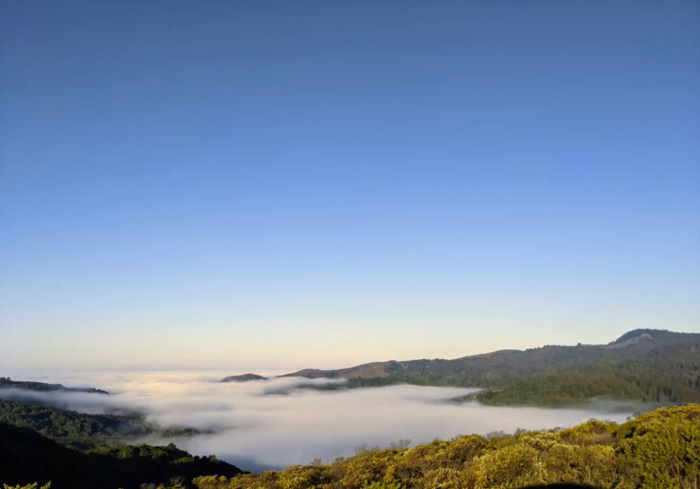Heating Death Valley
Take a tour of Death Valley

is licensed under CC BY-NC-SA 4.0(link is external)
Some people are surprised to learn that the rain on the redwoods is partly responsible for the heat of Death Valley, as we explore next in the text and in the video just below.
Warm air can hold more water than cool air. All air in nature has at least some water vapor in it, so if you cool air enough, water will begin to condense out of the air to make clouds that can rain or snow.
In nature, the air cools in two major ways—by losing energy to warm up its surroundings (by radiation or conduction), or by expanding as it is lifted. If warm tropical air flows toward one of the poles over colder land or water, the air cools while the land or water warms, and fog or clouds may form in the air. And, air that is lifted upward expands, and this expansion cools the air. You can experience this by feeling air becoming cold if it escapes rapidly from a high-pressure bicycle tire. Air that moves downward is compressed and warms, something you can feel if you keep your hand on the bicycle pump while you fill the tire again. In nature, air may be lifted when one air mass moves over another along a weather front, or when air moves up a mountain range. In either case, higher elevations have lower temperatures. (If it bothers you that cooler temperatures exist higher, but that cold air sinks, see the optional Enrichment—as explained there, cold air will sink if, after it warms while sinking, it is still colder than the air it replaces.)
Evaporation of water ultimately cools the surroundings of the water, and condensation warms the surroundings. To see this, remember that almost everything we see—including water—is made of fast-moving particles called atoms, or groups of atoms called molecules. If you have some water, such as the ocean or a drop of sweat on your skin, the average speed of the molecules will be higher if the water is warmer, but there always will be a range of speeds with some of the water molecules moving faster than others. The faster-moving, hotter molecules evaporate by breaking the attraction to their neighbors, leaving the slower, cooler ones behind, so evaporation always cools the remaining water. More heat then is conducted or radiated into this remaining water from its surroundings because heat flows from warmer to cooler places—your skin feels cool as it loses heat to the drop of sweat as it evaporates, and the ocean surface cools as water evaporates into the air.
Condensation reverses evaporation. Water condensing on a glass of iced tea warms the tea and the surrounding air. Condensation of water to form drops in clouds warms them, and they warm the surrounding air, releasing the energy that was stored when the water evaporated. (This energy that is stored during evaporation and released during condensation is called latent heat.)
Now, consider the wind blowing into California from the Pacific Ocean and rising up the Coast Ranges above the redwoods, and even farther up the Sierra Nevada above the giant sequoias, as shown in the video below As the air rises, the pressure on it (the weight of the air above) becomes smaller, and the air expands and cools. Once the air has cooled enough, it becomes saturated with water, and further cooling causes condensation. But the condensation releases some heat that partially counteracts the cooling from expansion. Air in which condensation is not occurring cools by about 1ºC for every 100 meters it is lifted, but when clouds and rain are forming the cooling is only about 0.6ºC for every 100 meters it is lifted (5ºF per 1000 feet dry, and 3ºF per 1000 feet wet). The difference represents the heat released by the condensation. This heat originally came from the sun, was stored in the air when the sun’s energy evaporated water, and was released to warm the air when the water condensed.
The strong breezes from the Pacific usually are full of water vapor, and begin to form clouds and fog as soon as they start to rise. This gives the common fogs of San Francisco and the Redwood Coast.
As you can see in the video below, those winds blowing over the Redwoods and the Sierra to Death Valley must rise about 15,000 feet to get over the Sierra, and cooling by 3ºF for every 1000 feet upward means the air cools about 45ºF going up. (Air that makes you feel comfortable at 70ºF at the coast will be 25ºF at the top, so take a warm jacket even in summer if you’re planning to climb in the high Sierra!) When this wind continues down the other side, it has lost almost all its water vapor and warms about 75ºF on the way back to sea level at the dry rate of 5ºF per 1000 feet. Thus, a comfortable 70ºF breeze on the Pacific Coast will be 100ºF when it nears the bottom of Death Valley. (Or, the air comes in from the Pacific at 21ºC, cools by 25ºC while rising 4200 m and cooling at 0.6ºC per hundred meters to -4ºC on top, then warms by 42ºC at 1ºC per hundred meters, reaching 38ºC at sea level on the edge of Death Valley.) Add a little solar heating through the cloudless desert air, and it is no wonder that Death Valley is hot! (And yes, the wind usually goes around the Sierra rather than over, so you haven’t learned everything about meteorology in part of one Module in a geology class, but it’s a start.)
Watch the following video that describes this process in more detail.
